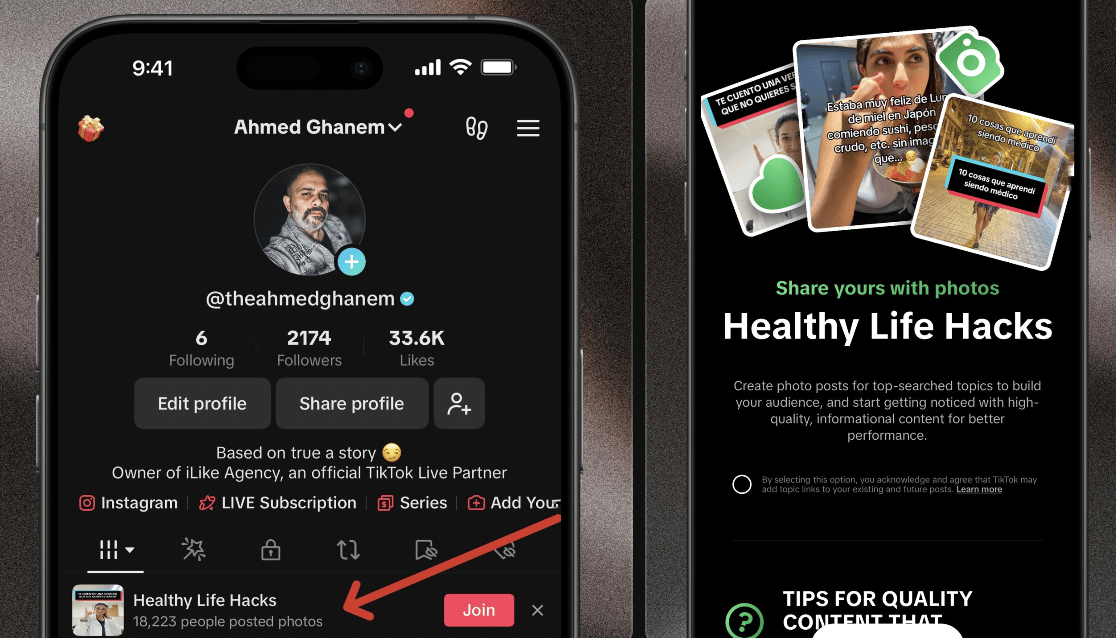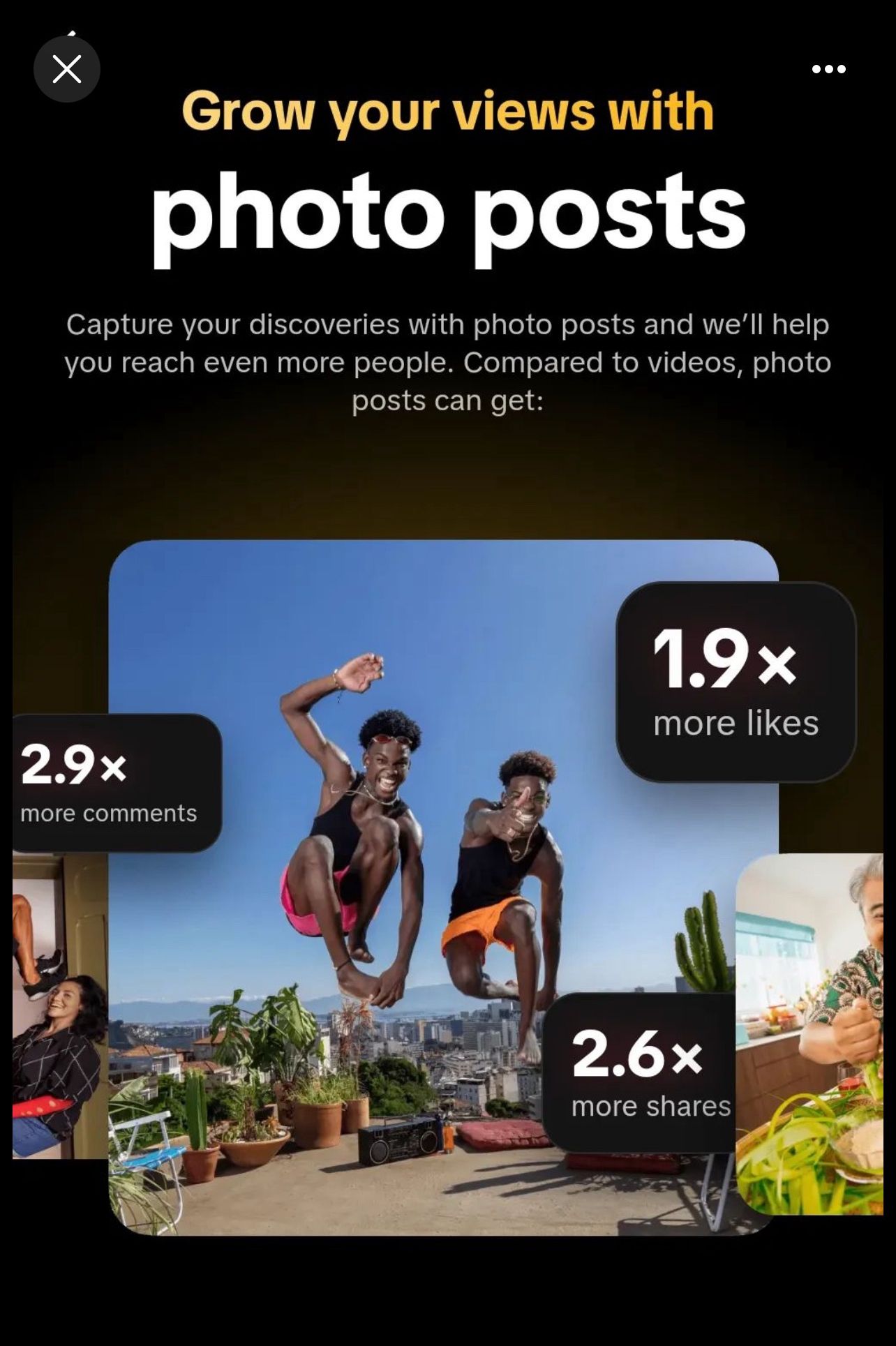
TikTok
TODAY’S EDITION
TikTok is pushing creators to share photo posts now
Meta rolls out tools for agencies to manage their creator talent
TikTok starts testing AI-generated narrators for product demos and how-to ads
YouTube makes it easier for audio-first creators to distribute their podcasts
Walmart’s latest AR investment recreates the shopping-with-friends experience
Interested in advertising in the newsletter or partnering together? Reply directly to this email or reach out here.
DEEP DIVE
TikTok Wants Creators To Post Photos Now

TikTok
TikTok's desire for creators to share longer videos is no secret. But photos, too? Recently, TikTok has been making a greater push for creators to post photo content.
TikTok’s Current Efforts for Photo Posts
Some users are receiving in-app notifications that highlight the benefits of photo posts, such as "1.9x more likes and 2.9x more comments than videos on average.”
Additionally, TikTok has started encouraging users to share photos related to certain categories via profile topic prompts. TikTok positions it as a way for creators to build their audience by creating photo posts for 'top-searched topics' and to get noticed with 'high-quality, informational content.’
Why the Push for Photos?
At a time when video content—both short and long—is the primary focus for many different platforms, TikTok’s push for photo content could seem misguided. However, here are a few reasons why photo content may be desired:
Appeal to More Creators: Despite Instagram's emphasis on Reels, it remains the go-to platform for photo-sharing among creators. While video content is more prevalent today, some creators still prioritize photos. Many of these creators heavily use Instagram, meaning TikTok is missing out on the pool of dedicated photo creators. Highlighting benefits, like increased engagement for photos on TikTok, can attract these creators to share their content on the platform.
Enhance Search and Discovery: TikTok's search engine-like experience is a significant value proposition for users. The production of more photo content can further strengthen the experience, as creators can add titles and have a smoother workflow for longer captions via Photo Mode. Photos and text can also be easier for platforms to categorize and index, making it more likely to connect users with relevant content during searches.
Drive Branded Content & Advertising: Some brands focus on Instagram-centric influencer marketing campaigns to acquire high-resolution photo assets from creators to use on their social channels and for paid media. Making this type of content more native to the platform can attract these brands, potentially prompting them to bring their influencer marketing campaigns to TikTok. As seen in recent years, once brands engage creators for sponsored content, they typically add a paid media component — which would benefit TikTok's advertising business. Carousels, one of its newer ad formats that supports scrollable, multiple images, is an option that TikTok can easily pitch to these brands, especially those that want to advertise multiple products.
So, What Does It Mean?
If there's one thing that creators and marketers should do when it comes to social media, it's not to overthink when platforms are pushing certain features, tools, or formats.
When platforms make a conscious effort to encourage users to do something, it's a signal to take action when possible and capitalize on the benefits that the platforms are promoting. This has been the case for Instagram with Reels, YouTube with Shorts, and even TikTok with long-form videos. Those who are early adopters typically see some type of payoff, whether it's increased reach or, sometimes, a less talked-about outcome: being quicker to understand what works for you or not.
Since most creators and brands are already producing photo content, jumping into photos on TikTok is a low lift with high potential. To optimize, photo posts should include an engaging title, a longer caption, text overlays that help move viewers from photo to photo (when sharing a carousel), and of course, audio, just like videos.
NEWS, TRENDS, AND INSIGHTS
Meta Launches Creator Management Tools for Agencies
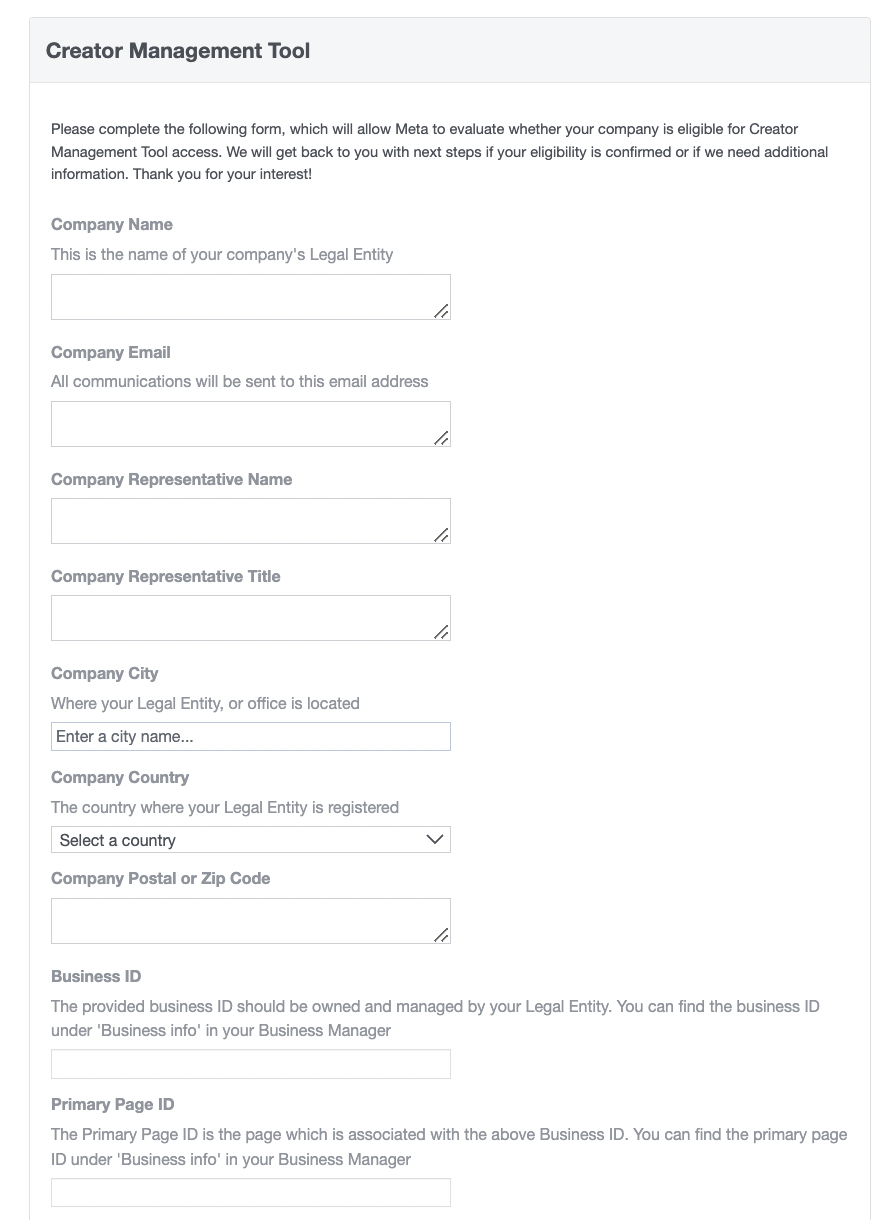
Meta
Meta has launched Creator Management Tools, a set of tools for agencies to manage their creator talent. With these tools, agencies can request and manage permissions for creators' assets (such as Facebook Pages and Instagram accounts), link payment accounts to creators' monetization features (e.g., Ads on Facebook Reels, Fan Subscriptions), and view insights into creators' earnings. Creators can control these permissions and access using their own set of new tools in Agency Management Tools.
Agencies can apply for access by filling out a form to share information about their company, how they work with creators, what creators they work with, and more.
Why It Matters: Creator Management Tools simplify how agencies collaborate and manage their talent across Meta. Instead of requiring creators' credentials or finding workarounds for distributing payments, agencies and creators can use these tools to streamline processes.
As the creator economy continues to grow, creators of all sizes are enlisting third parties like agencies to handle various aspects of their businesses. Agencies essentially function as extensions of creators, leading platforms to consider developing tools and experiences tailored to their unique workflows.
Last year, TikTok addressed this by launching a Talent Manager Portal for the TikTok Creator Marketplace.
TikTok Tests Realistic AI-Generated Narrators for Product Demos and How-To Ads
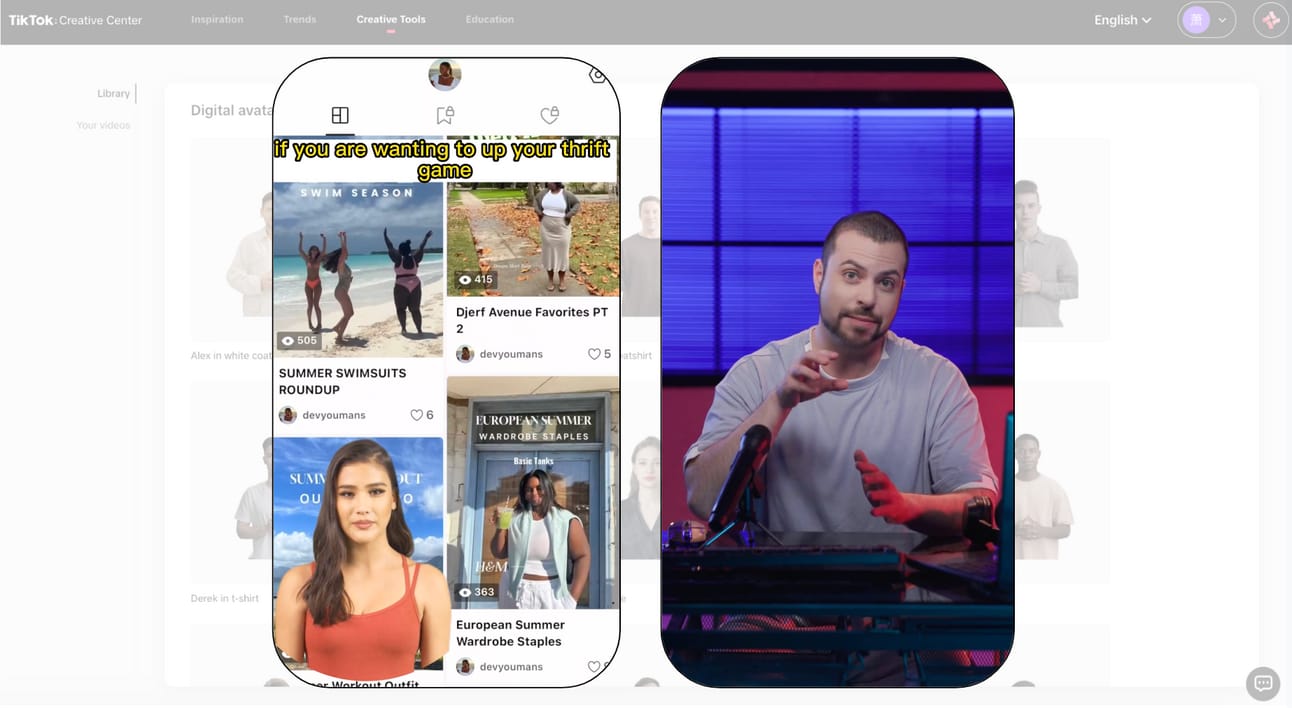
TikTok
TikTok is beta-testing Digital Avatars, a new creative product with select advertisers. Powered by AI, these avatars serve as narrators with physical movements, facial expressions, and voiceovers. Advertisers can choose from over 100 avatars varying in appearance, accents, and languages to be used for narrating product demos and how-to ads.
Why It Matters: Last year, many social platforms integrated AI tools, providing advertisers with the ability to create or modify assets for paid media ads. Digital Avatars, similar to AI Characters in TikTok's sister app, CapCut, offer advertisers realistic avatars that can star in content like humans.
While creators have been the go-to for paid media ads, AI now provides alternative options, bringing benefits such as cost efficiency and performance. Some advertisers may leverage AI over creators for these reasons, especially as it improves and becomes harder to distinguish from human-generated content.
But, a feature like this could also complement creators. Advertisers might use Digital Avatars as a test run to gauge how certain content may perform before engaging human creators to produce similar content.
YouTube Rolls Out Support for Podcast Uploads via RSS Feeds
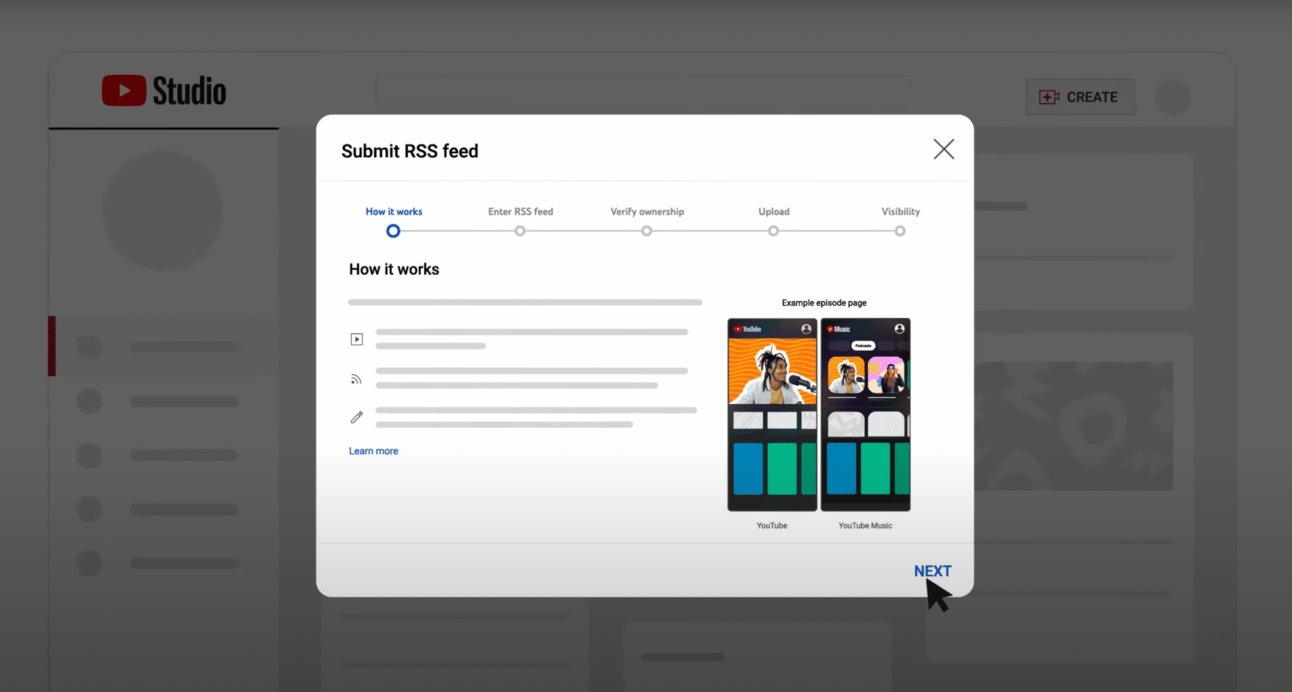
YouTube
YouTube has rolled out the ability for creators to upload podcasts using an RSS feed. Creators can submit their RSS feed, and after verification of ownership, YouTube will create static image videos using the show artwork for episodes and upload them to the creator’s channel. When new episodes are added to the RSS feed, YouTube automatically uploads them to the channel and notifies subscribers.
Why It Matters: Podcast creators have an easier way to distribute their podcasts on YouTube, one of the top destinations for podcast listening. While video podcasts have gained popularity, audio-first creators who have yet to move to video can still benefit from YouTube’s discoverability. This should encourage more podcasters to bring their shows to YouTube.
TikTok previously tested a feature allowing podcasters to link their RSS feeds to their accounts and tag episode videos. However, it discontinued the feature to invest in other initiatives.
Walmart Emulates The In-Store Shopping Experience With Shop With Friends
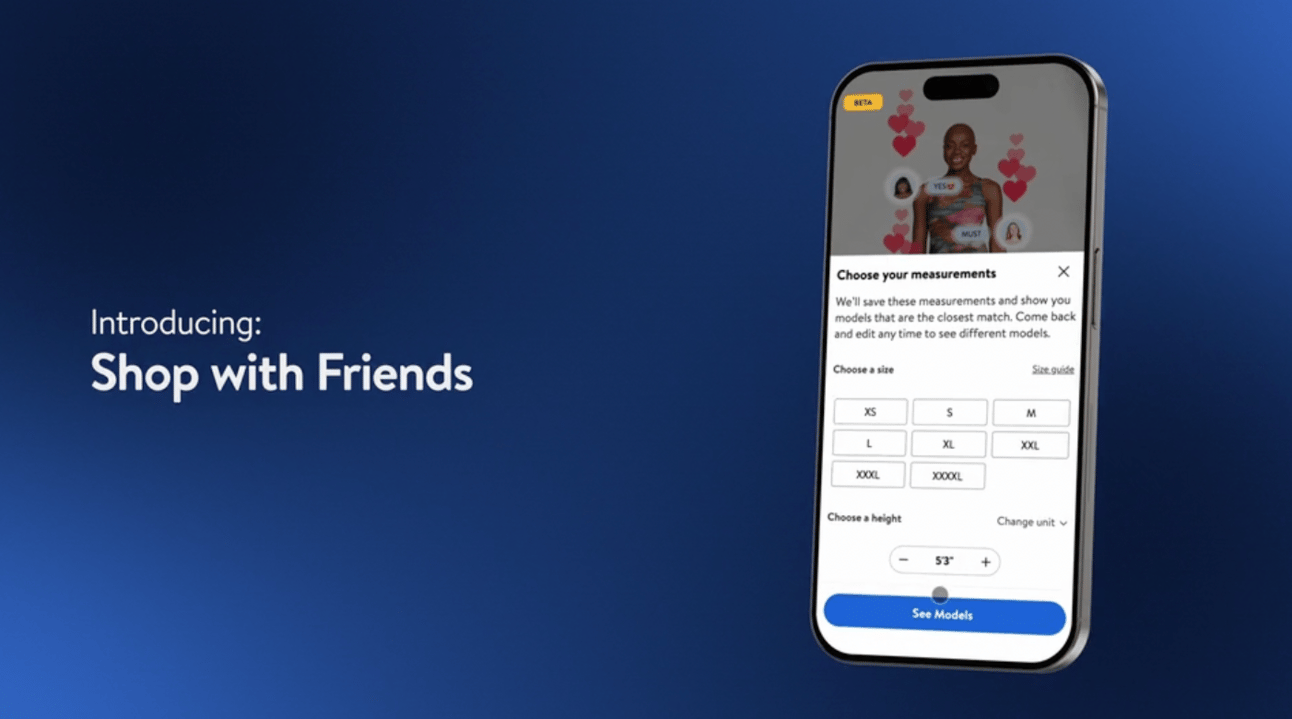
Walmart
Walmart introduced a new AR feature called Shop with Friends, allowing shoppers to virtually try on outfits and solicit feedback from their friends.
Shoppers begin by specifying their size and height, enabling Walmart to identify models that closely match their measurements. Subsequently, shoppers can dress the model in various looks and effortlessly share these stylized options with others through text, email, and other apps.
Why It Matters: Walmart is enhancing virtual shopping by adding a personalized and social touch. Allowing shoppers to select models based on their height and size ensures a more accurate representation of how outfits may fit and look. Additionally, the option to share these virtual fittings with others creates opportunities for feedback. Together, these features emulate in-person shopping experiences with friends and contribute to the company’s social commerce efforts.
Walmart could take this concept a step further by empowering shoppers to use a virtual version of themselves to try on fashion finds. This not only adds more personalization but also serves as a way for Walmart to promote user-generated content, as shoppers can share it across social media.
Head over to my website for more creator economy news, trends, and insights.
WHAT I’M READING
A look into Topicals’ playbook for influencer trips and why its trip with 12 BIPOC influencers to Accra, Ghana, was a hit.
As fashion content on Instagram and TikTok becomes saturated, email newsletters are increasingly becoming a go-to place for former editors and stylists to share their shopping recommendations.
Course platform Thinkific conducted a survey of over 2,500 creators for its latest report. The report identifies five trends that creator educators can take advantage of in 2024.
THANK YOU
Thank you for reading! If you've enjoyed this, please consider sharing it with a colleague or friend. If you have any feedback, ideas, tips, or questions, or would like to advertise in the newsletter or collaborate, please don't hesitate to reply to this email, reach out here, or send me a DM.

